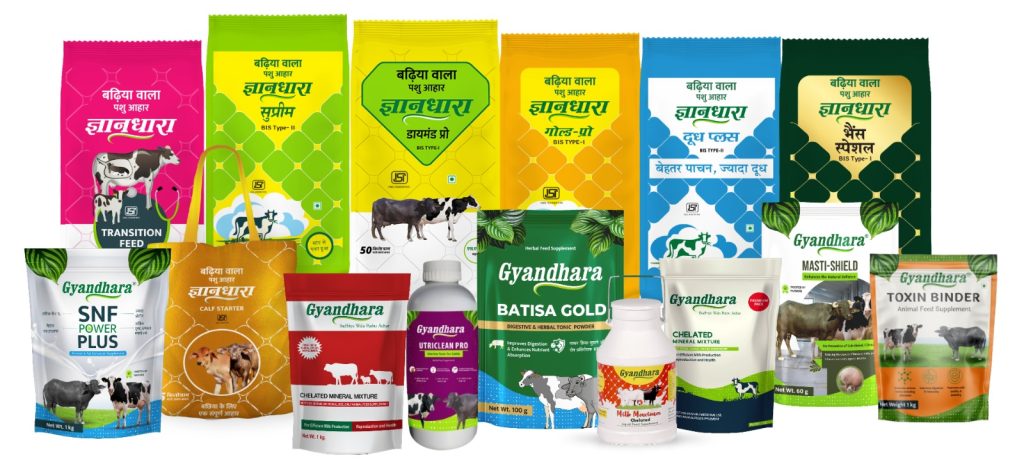Introduction
In dairy farming, feed selection is not just a routine task- it’s the foundation of profitability. The right feed directly impacts milk yield, cow health, reproduction, and veterinary costs. A balanced approach combines nutritional science with economic practicality, ensuring farmers get the best return on every rupee spent.
Thesis: Strategic feed selection optimizes productivity, strengthens herd health, and drives long-term sustainability in dairy operations.
Types of Cattle Feed
A. Forage-Based Feeds (60–70% of Dry Matter Intake)
- Pasture Systems: Low-cost, natural grazing; promotes healthy rumen activity. Works best with rotational grazing to avoid overgrazing.
- Hay:
- Grass Hay- High in fiber, supports rumen function.
- Legume Hay (e.g., alfalfa, lucerne)- Higher protein, ideal for high-producing cows.
- Grass Hay- High in fiber, supports rumen function.
- Silage:
- Corn Silage- Energy-dense, boosts milk yield.
- Haylage- Higher protein content, helps in peak lactation.
- Quality depends on proper fermentation and storage.
- Corn Silage- Energy-dense, boosts milk yield.
B. Concentrate Feeds (30–40% of Diet)
- Energy Sources: Corn, barley, bypass fats.
- Protein Sources: Soybean meal, canola meal, distillers’ grains (DDGS).
- By-Product Feeds: Cottonseed hulls, citrus pulp – cost-effective fillers but should be fed in moderation.
C. Specialty Supplements
- Minerals & Vitamins: Prevent deficiencies and support reproductive health.
- Functional Additives: Buffers, yeast cultures for digestion.
- Rumen Modifiers: Probiotics, ionophores for efficiency and reduced metabolic disorders.
Concentrates & Supplements: Precision Nutrition Tools
A. Energy Sources
- Corn: High starch (70–75%); boosts yield but needs buffers to prevent acidosis.
- Barley: Moderate starch (55–60%); safer for rumen health.
- Bypass Fats: Calcium salts of fatty acids; provide energy without rumen disruption (2–4% of diet DM).
B. Protein Boosters
- Soybean Meal: 44–48% CP; strong source of degradable protein.
- Canola Meal: More bypass protein, balances amino acids.
- DDGS: 26–30% CP, economical but should not exceed 20% of dry matter.
C. Functional Additives
- Buffers (Sodium Bicarbonate): Stabilize rumen pH.
- Yeast Cultures: Enhance fiber digestion and microbial protein yield.
- Ionophores (Monensin): Improve feed efficiency, reduce ketosis.
Benefits of Strategic Feeding
A. Production Benefits
- Higher milk yield and better fat/protein content.
B. Economic Benefits
- Lower feed cost per liter of milk.
- Reduced vet and medicine costs.
C. Herd Health Benefits
- Stronger immunity.
- Better fertility and calving outcomes.
- Longer productive lifespan.
D. Operational Benefits
- Improved feed efficiency.
- Reduced waste and environmental impact.
Matching Feed to Stage & Resources
A. Production Stage Matching
- Fresh Cows (0–21 DIM): High-energy diets with protected amino acids.
- Peak Lactation (22–150 DIM): Dense energy + protein (16–18% CP).
- Dry Cows: High-fiber, low-energy rations to prevent metabolic issues.
B. Cost-Benefit Analysis
- By-products (DDGS, citrus pulp) are viable if priced below 85% of corn value.
- Forage-concentrate balance: High forage = herd health, High concentrate = yield.
C. Avoiding Pitfalls
- Test silage for mycotoxins; use binders if aflatoxin >20 ppb.
- Avoid overfeeding concentrates (>5–6 kg/day)- prevents SARA & laminitis.
Conclusion
An ideal dairy ration balances:
- 60–70% Forages
- 30–40% Concentrates
- Minerals & Additives
The golden rule: Quality matters more than cost. Good forages cut down concentrate needs and lower veterinary expenses. Dairy farmers who test feeds, formulate balanced rations, and track herd response see the best productivity and sustainability outcomes.
FAQs
Yes, if limited to ≤20% of diet dry matter.
Corn silage = energy; haylage = protein. Use both for balance.
No, high-yielders need additional concentrates for energy and protein.
Acidosis, laminitis, reduced milk fat – always balance with fiber.
At least every production stage (fresh, peak, dry cows), or every 90 days.

